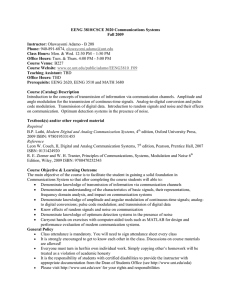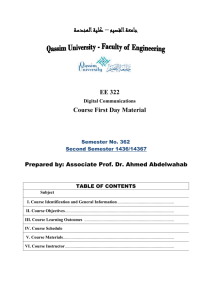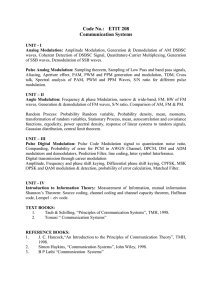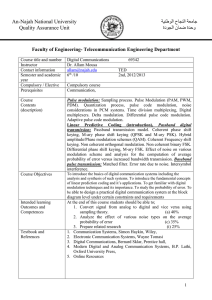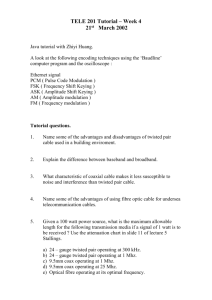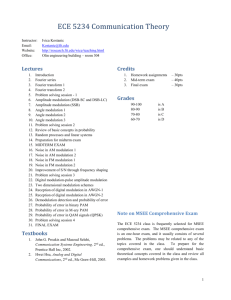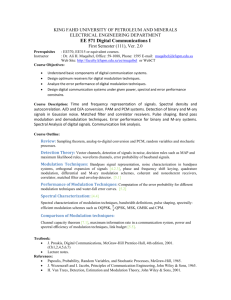Gazi University
advertisement
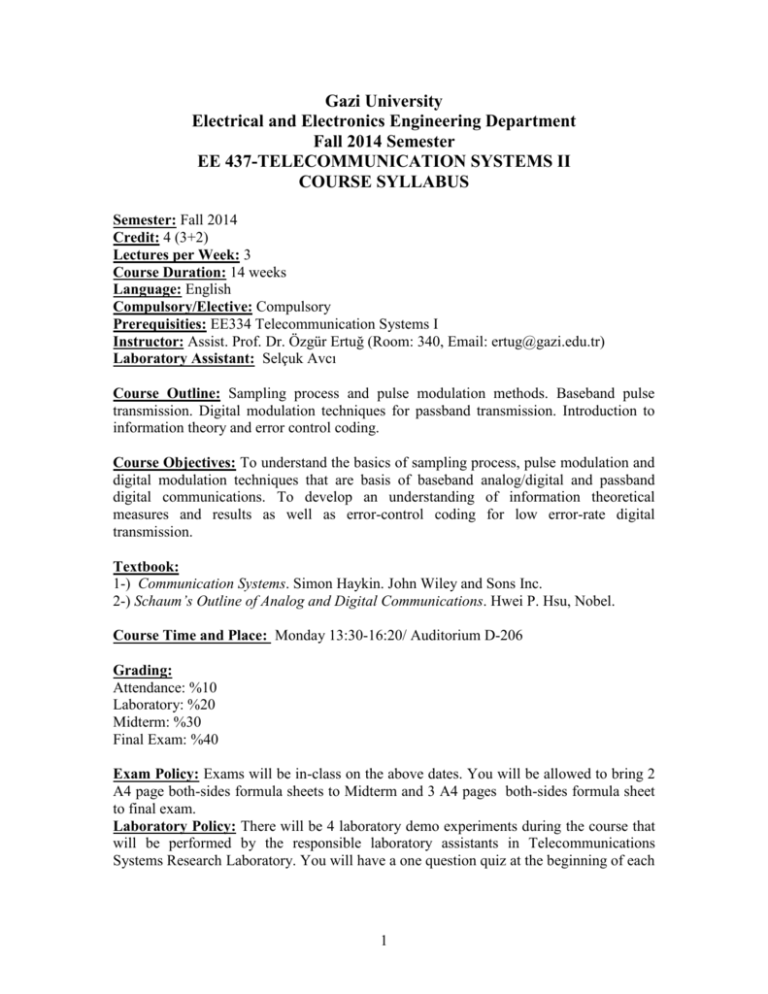
Gazi University Electrical and Electronics Engineering Department Fall 2014 Semester EE 437-TELECOMMUNICATION SYSTEMS II COURSE SYLLABUS Semester: Fall 2014 Credit: 4 (3+2) Lectures per Week: 3 Course Duration: 14 weeks Language: English Compulsory/Elective: Compulsory Prerequisities: EE334 Telecommunication Systems I Instructor: Assist. Prof. Dr. Özgür Ertuğ (Room: 340, Email: ertug@gazi.edu.tr) Laboratory Assistant: Selçuk Avcı Course Outline: Sampling process and pulse modulation methods. Baseband pulse transmission. Digital modulation techniques for passband transmission. Introduction to information theory and error control coding. Course Objectives: To understand the basics of sampling process, pulse modulation and digital modulation techniques that are basis of baseband analog/digital and passband digital communications. To develop an understanding of information theoretical measures and results as well as error-control coding for low error-rate digital transmission. Textbook: 1-) Communication Systems. Simon Haykin. John Wiley and Sons Inc. 2-) Schaum’s Outline of Analog and Digital Communications. Hwei P. Hsu, Nobel. Course Time and Place: Monday 13:30-16:20/ Auditorium D-206 Grading: Attendance: %10 Laboratory: %20 Midterm: %30 Final Exam: %40 Exam Policy: Exams will be in-class on the above dates. You will be allowed to bring 2 A4 page both-sides formula sheets to Midterm and 3 A4 pages both-sides formula sheet to final exam. Laboratory Policy: There will be 4 laboratory demo experiments during the course that will be performed by the responsible laboratory assistants in Telecommunications Systems Research Laboratory. You will have a one question quiz at the beginning of each 1 lab session. Laboratory sessions for each student will be determined in the first two weeks of the semester. Web Page: Course announcements will be made through the course page under Dr. Ertuğ’s web page http://w3.gazi.edu.tr/~ertug/. COURSE CONTENTS: Week 1 : Introduction to random processes, probability theory, random variables, statistical averages, transformations of random variables Week 2 : Random processes, stationarity, mean, correlation and covariance functions, ergodicity, transmission of ramdom processes through a linear filter, power spectral density, Gaussian processes and noise, properties of noise, signals in noise Week 3 : Sampling process, pulse amplitude modulation, time-division multiplexing, pulse-position modulation Week 4 : Quantization, pulse-code modulation, noise effects in PCM, Week 5: Baseband pulse transmission, matched filter, error rate due to noise, intersymbol interference, Nyquist signalling for no ISI Week 6: Correlative level coding, M-ary PAM, tapped-delay line equalization, adaptive equalization, decision-feedback equalization, eye pattern Week 7: Transmission model for digital passband transmission, Gram-Schmidt orthogonalization, geometric interpretation of signals Week 8: Correlator banks, coherent detection of signals in noise, maximum likelihood decoder Week 9: Midterm Week 10: Probability of error in maximum likelihood detection, correlation receiver, equivalance of correlation and matched filter receivers, detection of signals with unknown phase, hierarchy of digital modulation techniques, coherent binary PSK, coherent binary FSK Week 11: Coherent quadriphase-shift keying, coherent minimum shift keying , GMSK, M-ary FSK Week 12: Detection of signals with unknown phase, noncoherent orthogonal modulation, noncoherent binary frequency-shift keying, differential phase-shift keying, M-ary modulation, bandwidth efficiency Week 13: Introduction to information theory. Mutual information and capacity definitions. Capacity of discrete memoryless and continous channels Week 14: Introduction to error control coding. Linear block codes, cyclic codes and convolutional codes. Related encoding techniques and decoding algorithms. 2

